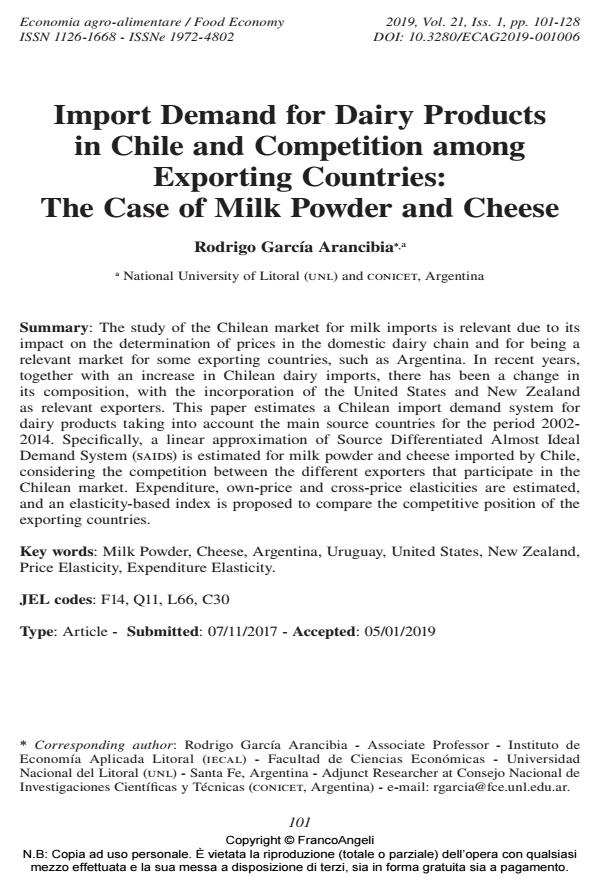Import Demand for Dairy Products in Chile and Competition among Exporting Countries: The Case of Milk Powder and Cheese
Titolo Rivista ECONOMIA AGRO-ALIMENTARE
Autori/Curatori Rodrigo García Arancibia
Anno di pubblicazione 2019 Fascicolo 2019/1
Lingua Inglese Numero pagine 28 P. 101-128 Dimensione file 245 KB
DOI 10.3280/ECAG2019-001006
Il DOI è il codice a barre della proprietà intellettuale: per saperne di più
clicca qui
Qui sotto puoi vedere in anteprima la prima pagina di questo articolo.
Se questo articolo ti interessa, lo puoi acquistare (e scaricare in formato pdf) seguendo le facili indicazioni per acquistare il download credit. Acquista Download Credits per scaricare questo Articolo in formato PDF

FrancoAngeli è membro della Publishers International Linking Association, Inc (PILA)associazione indipendente e non profit per facilitare (attraverso i servizi tecnologici implementati da CrossRef.org) l’accesso degli studiosi ai contenuti digitali nelle pubblicazioni professionali e scientifiche
The study of the Chilean market for milk imports is relevant due to its impact on the determination of prices in the domestic dairy chain and for being a relevant market for some exporting countries, such as Argentina. In recent years, together with an increase in Chilean dairy imports, there has been a change in its composition, with the incorporation of the United States and New Zealand as relevant exporters. This paper estimates a Chilean import demand system for dairy products taking into account the main source countries for the period 2002- 2014. Specifically, a linear approximation of Source Differentiated Almost Ideal Demand System (saids) is estimated for milk powder and cheese imported by Chile, considering the competition between the different exporters that participate in the Chilean market. Expenditure, own-price and cross-price elasticities are estimated, and an elasticity-based index is proposed to compare the competitive position of the exporting countries.
Parole chiave:Milk Powder, Cheese, Argentina, Uruguay, United States, New Zealand, Price Elasticity, Expenditure Elasticity.
Jel codes:F14, Q11, L66, C30
- Farewell Editorial for the Issue 3/2024 Maurizio Canavari, Sedef Akgüngör, Valeria Borsellino, Alessio Cavicchi, Catherine Chan, Alessio Ishizaka, Simona Naspetti, Søren Marcus Pedersen, Stefanella Stranieri, in Economia agro-alimentare 3/2025 pp.7
DOI: 10.3280/ecag2024oa19047 - Competitividad de las exportaciones argentinas de quesos y leche en polvo: Un análisis a partir de la demanda externa de los principales importadores Mariano Nicolas Coronel, Rodrigo García Arancibia, Jimena Vicentin Masaro, in Estudios económicos /2022 pp.187
DOI: 10.52292/j.estudecon.2022.2350
Rodrigo García Arancibia, Import Demand for Dairy Products in Chile and Competition among Exporting Countries: The Case of Milk Powder and Cheese in "ECONOMIA AGRO-ALIMENTARE" 1/2019, pp 101-128, DOI: 10.3280/ECAG2019-001006